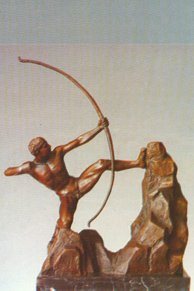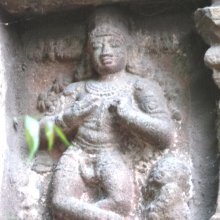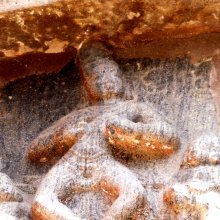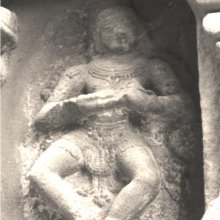Sucimukha, Sūcimukha, Sūcīmukha, Suci-mukha: 20 definitions
Introduction:
Sucimukha means something in Buddhism, Pali, Hinduism, Sanskrit, Marathi. If you want to know the exact meaning, history, etymology or English translation of this term then check out the descriptions on this page. Add your comment or reference to a book if you want to contribute to this summary article.
Alternative spellings of this word include Suchimukha.
Images (photo gallery)
In Hinduism
Purana and Itihasa (epic history)
Source: archive.org: Puranic Encyclopedia1) Sūcimukha (सूचिमुख).—A hell. (See under Kāla the section on hell).
2) Sūcīmukha (सूचीमुख) or Sūcīmukhavyūha refers to the “Disposition of an army which is like the needle-eye”.—Disposition of an army (vyūha) of four parts, (infantry, cavalry, elephants and chariots) in the battlefield, the arrangement of it, in various forms. It is said that during the period of Mahābhārata, there were various forms of disposition of the army.—Sūcīmukha-vyūha is mentioned in the Mahābhārata Bhīṣma Parva, Chapter 77.
Source: Cologne Digital Sanskrit Dictionaries: The Purana Index1a) Sūcīmukha (सूचीमुख).—One of twenty-eight hells, intended for the haughty and the miserly.*
- * Bhāgavata-purāṇa V. 26. 7 and 36.
1b) A commander of Bhaṇḍa: killed by Tiraskarṇikā.*
- * Brahmāṇḍa-purāṇa IV. 21. 78; 24. 9, 44, 96.
1c) A Piśāca clan.*
- * Vāyu-purāṇa 69. 265.

The Purana (पुराण, purāṇas) refers to Sanskrit literature preserving ancient India’s vast cultural history, including historical legends, religious ceremonies, various arts and sciences. The eighteen mahapuranas total over 400,000 shlokas (metrical couplets) and date to at least several centuries BCE.
Natyashastra (theatrics and dramaturgy)
Source: Wisdom Library: Nāṭya-śāstra1) Sūcīmukha (सूचीमुख) refers to a gesture (āṅgika) made with a ‘single hand’ (asaṃyuta), according to the Nāṭyaśāstra chapter 8. It is also known by the name Sūcyāsya. The hands (hasta) form a part of the human body which represents one of the six major limbs (aṅga) used in dramatic performance. With these limbs are made the various gestures (āṅgika), which form a part of the histrionic representation (abhinaya).
2) Sūcīmukha (सूचीमुख) is another name for Sūcyāsya, a Sanskrit technical term referring to a gesture (āṅgika) made with ‘dance hands’ (nṛttahasta), according to the Nāṭyaśāstra chapter 8. It is also known by the name Sūcīmukha.
Source: archive.org: Natya Shastra1) Sūcīmukha (सूचीमुख).—A type of gesture (āṅgika) made with a single hand (asaṃyuta-hasta);—(Instructions): The fore finger of the Kaṭakāmukha hand to be stretched.
(Uses): I shall tell you briefly of its various uses as the forefinger [in it] is raised and bent, moving sideways, shaking, moving up and down, and moving up without any rest. By moving the forefinger upwards [in this hand] are to be represented discus, lightning, banners, blossoms, earring, zigzag movement, a cry of approbation, young serpent, young sprout, incense, lamp, creepers, Śikhaṇḍa, falling down, curve and roundness and with the forefinger raised this [hand] again should be used in [representing] stars, nose, [the number] one, club and stick.
2) Sūcīmukha (सूचीमुख).—A type of gesture (āṅgika) made with dance-hands (nṛttahasta);—(Instructions): The two Sarpaśiraḥ hands with their thumbs touching middle fingers are to stretch their tips obliquely. The Dance-hands are to be used in forming Karaṇas.

Natyashastra (नाट्यशास्त्र, nāṭyaśāstra) refers to both the ancient Indian tradition (shastra) of performing arts, (natya—theatrics, drama, dance, music), as well as the name of a Sanskrit work dealing with these subjects. It also teaches the rules for composing Dramatic plays (nataka), construction and performance of Theater, and Poetic works (kavya).
Dhanurveda (science of warfare)
Source: Wisdom Library: DhanurvedaSūcīmukha (सूचीमुख) refers to a kind of weapon (the point of a needle). It is a Sanskrit word defined in the Dhanurveda-saṃhitā, which contains a list of no less than 117 weapons. The Dhanurveda-saṃhitā is said to have been composed by the sage Vasiṣṭha, who in turn transmitted it trough a tradition of sages, which can eventually be traced to Śiva and Brahmā.

Dhanurveda (धनुर्वेद) refers to the “knowledge of warfare” and, as an upaveda, is associated with the Ṛgveda. It contains instructions on warfare, archery and ancient Indian martial arts, dating back to the 2nd-3rd millennium BCE.
Shaktism (Shakta philosophy)
Source: Wisdom Library: Śrīmad Devī BhāgavatamSūcimukha (सूचिमुख) refers to one of the thirty hells (naraka) mentioned in the Devī-bhāgavata-purāṇa 8.21 (on the narrative of hells). The hells are destinations where dead beings brought by messengers of Yama (the God of the Pitṛs), and get punished by him according to their karmas and faults.
The Devī-bhāgavata-purāṇa or Śrīmad-devī-bhāgavatam (mentioning Sūcimukha), is categorised as a Mahāpurāṇa, a type of Sanskrit literature containing cultural information on ancient India, religious/spiritual prescriptions and a range of topics concerning the various arts and sciences. The whole text is composed of 18,000 metrical verses, possibly originating from before the 6th century.

Shakta (शाक्त, śākta) or Shaktism (śāktism) represents a tradition of Hinduism where the Goddess (Devi) is revered and worshipped. Shakta literature includes a range of scriptures, including various Agamas and Tantras, although its roots may be traced back to the Vedas.
Ayurveda (science of life)
Rasashastra (Alchemy and Herbo-Mineral preparations)
Source: Wisdom Library: Rasa-śāstraSūcīmukha (सूचीमुख) is the name of an Ayurvedic recipe defined in the fourth volume of the Rasajalanidhi (chapter 2, dealing with jvara: fever). These remedies are classified as Iatrochemistry and form part of the ancient Indian science known as Rasaśāstra (medical alchemy). However, as an ayurveda treatment, it should be taken twith caution and in accordance with rules laid down in the texts.
Accordingly, when using such recipes (e.g., sūcīmukha-rasa): “the minerals (uparasa), poisons (viṣa), and other drugs (except herbs), referred to as ingredients of medicines, are to be duly purified and incinerated, as the case may be, in accordance with the processes laid out in the texts.” (see introduction to Iatro chemical medicines)

Āyurveda (आयुर्वेद, ayurveda) is a branch of Indian science dealing with medicine, herbalism, taxology, anatomy, surgery, alchemy and related topics. Traditional practice of Āyurveda in ancient India dates back to at least the first millenium BC. Literature is commonly written in Sanskrit using various poetic metres.
Kavya (poetry)
Source: Wisdom Library: KathāsaritsāgaraSūcīmukha (सूचीमुख) is the name of a bird, according to the Kathāsaritsāgara, chapter 59. Accordingly, as Karaṭaka said to Damanaka: “... whoever says much to a person who despises good advice, incurs thereby misfortune, as Sūcīmukha from the ape..”.
The Kathāsaritsāgara (‘ocean of streams of story’), mentioning Sūcīmukha, is a famous Sanskrit epic story revolving around prince Naravāhanadatta and his quest to become the emperor of the vidyādharas (celestial beings). The work is said to have been an adaptation of Guṇāḍhya’s Bṛhatkathā consisting of 100,000 verses, which in turn is part of a larger work containing 700,000 verses.

Kavya (काव्य, kavya) refers to Sanskrit poetry, a popular ancient Indian tradition of literature. There have been many Sanskrit poets over the ages, hailing from ancient India and beyond. This topic includes mahakavya, or ‘epic poetry’ and natya, or ‘dramatic poetry’.
In Buddhism
Mahayana (major branch of Buddhism)
Source: Wisdom Library: Maha Prajnaparamita SastraSūcimukha (सूचिमुख) refers to “one having a mouth like the eye of a needle”, according Mahāprajñāpāramitāśāstra (chapter XLVI).—There are two kinds of Pretas: lecherous Pretas and emaciated Pretas (kṣutkṣāma). The lecherous Pretas enjoy happiness like the gods but they live with the starving Pretas of whom they are the leaders. The starving Pretas have an enormous belly (sthūlodara) like a mountain, a mouth like the eye of a needle (sūcimukha) and consist of three things: a black skin (kṛṣṇatvac), tendons (snāyu) and bones (asthi). For innumerable hundreds of years, they have not even heard the words “food and drink” (annapāna), still less have they seen their shapes.

Mahayana (महायान, mahāyāna) is a major branch of Buddhism focusing on the path of a Bodhisattva (spiritual aspirants/ enlightened beings). Extant literature is vast and primarely composed in the Sanskrit language. There are many sūtras of which some of the earliest are the various Prajñāpāramitā sūtras.
Languages of India and abroad
Pali-English dictionary
Source: BuddhaSasana: Concise Pali-English Dictionarysūcimukha : (m.) a mosquito.
Source: Sutta: The Pali Text Society's Pali-English DictionarySūcimukha refers to: “needle-mouthed, ” a mosquito Abhp 646; a sort of intestinal worm; °ā pāṇā (in the Gūthaniraya purgatory) M. III, 185.
Note: sūcimukha is a Pali compound consisting of the words sūci and mukha.

Pali is the language of the Tipiṭaka, which is the sacred canon of Theravāda Buddhism and contains much of the Buddha’s speech. Closeley related to Sanskrit, both languages are used interchangeably between religions.
Marathi-English dictionary
Source: DDSA: The Aryabhusan school dictionary, Marathi-Englishsūcimukha (सूचिमुख).—a Pointed, peaked, tapering.
Marathi is an Indo-European language having over 70 million native speakers people in (predominantly) Maharashtra India. Marathi, like many other Indo-Aryan languages, evolved from early forms of Prakrit, which itself is a subset of Sanskrit, one of the most ancient languages of the world.
Sanskrit dictionary
Source: DDSA: The practical Sanskrit-English dictionarySūcimukha (सूचिमुख) or Sūcīmukha (सूचीमुख).—a.
1) needle-mouthed, having a pointed beak.
2) pointed. (-khaḥ) 1 a bird.
2) white Kuśa grass.
3) a particular position of the hands.
-kham a diamond.
Sūcimukha is a Sanskrit compound consisting of the terms sūci and mukha (मुख).
Source: Cologne Digital Sanskrit Dictionaries: Shabda-Sagara Sanskrit-English DictionarySūcimukha (सूचिमुख).—n.
(-khaṃ) The diamond. m.
(-khaḥ) 1. A bird. 2. The white Kuśa grass. 3. A particular position of the hands. E. sūci a needle or a beak, and mukha mouth.
Source: Cologne Digital Sanskrit Dictionaries: Benfey Sanskrit-English DictionarySūcīmukha (सूचीमुख).—I. m. a bird. Ii. f. khī, a female bird, [Pañcatantra] i. [distich] 437. Iii. n. a diamond.
Sūcīmukha is a Sanskrit compound consisting of the terms sūcī and mukha (मुख).
Source: Cologne Digital Sanskrit Dictionaries: Cappeller Sanskrit-English DictionarySūcīmukha (सूचीमुख).—1. [neuter] point of a needle.
--- OR ---
Sūcīmukha (सूचीमुख).—2. [feminine] ī needle-mouthed, pointed; [masculine] a kind of insect or bird.
Source: Cologne Digital Sanskrit Dictionaries: Monier-Williams Sanskrit-English Dictionary1) Sūcīmukha (सूचीमुख):—[=sūcī-mukha] [from sūcī > sūc] n. the point of a needle (also khāgra), [Kāvya literature; Suśruta]
2) [v.s. ...] a [particular] hell, [Bhāgavata-purāṇa]
3) [v.s. ...] mf(ī)n. having a beak etc. as sharp as a n°, [Atharva-veda; Pañcatantra]
4) [v.s. ...] pointed or sharp as a needle, [Mahābhārata]
5) [v.s. ...] narrow (cf. -vaktra), [Caraka; Śārṅgadhara-saṃhitā]
6) [v.s. ...] (only [cf. Lexicographers, esp. such as amarasiṃha, halāyudha, hemacandra, etc.]) a bird (or a [particular] bird or Name of a bird), [Kathāsaritsāgara; Pañcatantra]
7) [v.s. ...] a kind of Kuśa grass
8) [v.s. ...] a gnat or some other stinging insect
9) [v.s. ...] a [particular] position of the hands
10) [=sūcī-mukha] [from sūcī > sūc] n. a diamond, [cf. Lexicographers, esp. such as amarasiṃha, halāyudha, hemacandra, etc.]
Source: Cologne Digital Sanskrit Dictionaries: Yates Sanskrit-English DictionarySūcīmukha (सूचीमुख):—[sūcī-mukha] (khaṃ) 1. n. A daimond; a hell.
[Sanskrit to German]
Sanskrit, also spelled संस्कृतम् (saṃskṛtam), is an ancient language of India commonly seen as the grandmother of the Indo-European language family (even English!). Closely allied with Prakrit and Pali, Sanskrit is more exhaustive in both grammar and terms and has the most extensive collection of literature in the world, greatly surpassing its sister-languages Greek and Latin.
Kannada-English dictionary
Source: Alar: Kannada-English corpusSūcimukha (ಸೂಚಿಮುಖ):—[noun] = ಸೂಚೀಮುಖ [sucimukha].
--- OR ---
Sūcīmukha (ಸೂಚೀಮುಖ):—
1) [noun] the pointed end of a needle.
2) [noun] any animal that has pointed face.
3) [noun] the front portion of an army, arrayed in the form of a needle.
4) [noun] (dance.) holding hand before the chest, palm turned outwards, with the forefinger stretched out straight and other fingers bent towards the palm, thumb is placed on them.
Kannada is a Dravidian language (as opposed to the Indo-European language family) mainly spoken in the southwestern region of India.
See also (Relevant definitions)
Partial matches: Mukha, Shuci.
Starts with: Sucimukhagrasambhedya, Sucimukharasa, Sucimukhavyuha.
Full-text: Sucyasya, Sucimukhagrasambhedya, Sucihasta, Sucyagra, Shucimukhi, Kaka, Ardharecita, Sucimukhavyuha, Sthulodara, Asamyuta, Krishnatvac, Kshutkshama, Sucividdha, Tapasya, Naraka, Snayu, Shuci, Phala, Khasarpana.
Relevant text
Search found 14 books and stories containing Sucimukha, Suci-mukha, Sūci-mukha, Sūcī-mukha, Sūcimukha, Sūcīmukha; (plurals include: Sucimukhas, mukhas, Sūcimukhas, Sūcīmukhas). You can also click to the full overview containing English textual excerpts. Below are direct links for the most relevant articles:
The Bhagavata Purana (by G. V. Tagare)
Chapter 26 - Description of Hells (Naraka) < [Book 5 - Fifth Skandha]
Vastu-shastra (2): Town Planning (by D. N. Shukla)
Lalitopakhyana (Lalita Mahatmya) (by G.V. Tagare)
The Devi Bhagavata Purana (by Swami Vijñanananda)
Chapter 32 - On the enumeration of various hells for sinners < [Book 9]
Chapter 21 - On the narrative of hells < [Book 8]
Chapter 23 - On the description of the remaining hells < [Book 8]
The Shiva Purana (by J. L. Shastri)
Chapter 9 - Pangs of hell < [Section 5 - Umā-Saṃhitā]
Chapter 8 - Description of the Hell (naraka) < [Section 5 - Umā-Saṃhitā]
Natyashastra (English) (by Bharata-muni)


